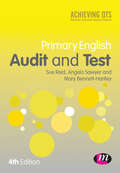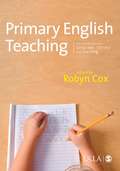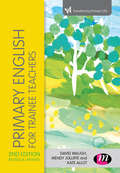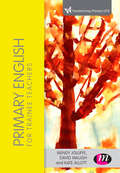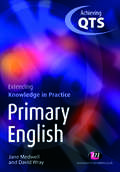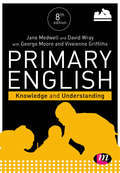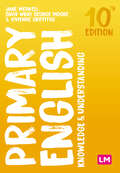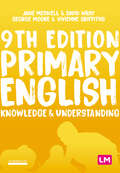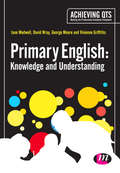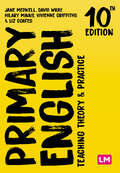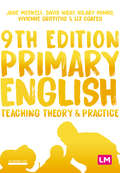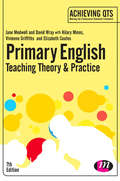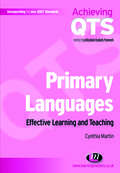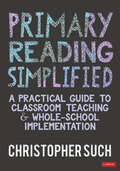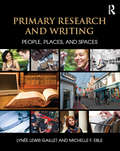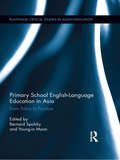- Table View
- List View
Primary English Audit and Test (Achieving QTS Series)
by Sue Reid Mary Bennett-Hartley Angela SawyerThis popular, widely recommended, text supports trainees on primary initial teacher training courses where a secure knowledge and understanding of English is required for the award of Qualified Teacher Status (QTS). A rigorous and focused test enables trainees to identify their strengths and weaknesses in English. This test can be revisited at key stages in their course as a tool to monitor and evaluate progress. The fourth edition has been updated in line with the new National Curriculum, includes more information on expanding and developing a knowledge of English and is linked to the 2012 Teachers' Standards.
Primary English Knowledge and Understanding
by George Moore Jane Medwell David Wray Vivienne GriffithsThe essential subject knowledge text for primary English. Secure subject knowledge and understanding is the foundation of confident, creative and effective teaching. The 5th edition of this popular text has a number of new features including a new self assessment section and M level extension boxes to provide further challenge in all chapters. References to the 2007 QTS Standards and the Early Years Foundation Stage are also included. With full coverage of the English curriculum, and updated research summaries reflecting the latest thinking, this text is written to help trainee primary teachers develop and consolidate their knowledge of English.
Primary English Teaching: An Introduction to Language, Literacy and Learning (Published in association with the UKLA)
by Robyn CoxThis comprehensive introduction to language, literacy and learning in the primary school, explores the theoretical issues that underpin pedagogical practice in the primary English language classroom in a straightforward manner, enabling readers to understand the resulting practice and curriculum offerings in English primary schools today.<P><P> The contributors explore new initiatives in primary language teaching, putting these into their theoretical context, and offer practical ideas, helping students to make the bridge from studying to be a teacher, through to the beginnings of their teaching career. Diversity and aspects of special educational needs are also considered in each section of the book.<P> This book will be essential reading both for undergraduate students of education, as well as for PGCE students.
Primary English for Trainee Teachers (Transforming Primary QTS Series)
by David Waugh Wendy Jolliffe Kate AllottWhat do trainee teachers need to know about English to teach it effectively in primary schools? How do children learn English and how can students teach it? What does a good primary English lesson look like? Answering these important questions and more, this new edition covers all areas of the new National Curriculum for primary English. By offering insight into effective teaching, it helps students connect what they need to teach to how it can be taught. This book opens up opportunities in the new curriculum for creative and imaginative teaching and covers all areas of children's literacy from poetry and literature to SPAG. Case studies of teaching are used as a starting point for learning, and guidance on practical teaching strategies is included throughout. Now comes with: A new chapter on Multi-modal texts A new chapter on Mastery in English
Primary English for Trainee Teachers (Transforming Primary Qts Ser.)
by David Waugh Wendy Jolliffe Kate AllottWith chapter sequencing following the new Curriculum, this book supports you to make use of the opportunities presented in the National Curriculum for effective and engaging Primary English teaching. Covering all areas of the new National Curriculum for primary English and offering insight into effective teaching, it helps you connect what you need to teach, to how it can be taught. It opens up the opportunities in the new curriculum for creative and imaginative teaching and covers all areas of children's literacy from poetry and literature to SPAG. Throughout the text, case studies of teaching are used as a starting point for learning and guidance on practical teaching strategies is included in all chapters. A comprehensive guide to the teaching of primary English that will help you secure your subject knowledge and transform your teaching. Includes the full National Curriculum Programme of Study for English, key stages 1 and 2 as a useful reference for trainee teachers.
Primary English: Audit and Test
by Doreen ChallenThis book supports trainees on primary initial teacher training courses where a secure knowledge and understanding of English is required for the award of Qualified Teacher Status (QTS). A rigorous test enables trainees to identify their strengths and weaknesses in English and this can be revisited in order to monitor and evaluate progress towards QTS. Trainees are able to direct their studies more usefully and quickly develop confidence in topics they find difficult. This edition is fully up to date with the 2007 QTS Standards.
Primary English: Knowledge And Understanding (Achieving QTS Extending Knowledge in Practice LM Series)
by David Wray Jane A MedwellStill the biggest concern for many on initial teacher training courses is the acquisition of subject knowledge and the ability to translate that into effective teaching. This book addresses this - building on the core subject knowledge covered in the Achieving QTS series and relating it to classroom practice. It supports trainees in extending and deepening their knowledge of English and demonstrating how to apply it to planning and implementing lessons. Practical and up-to-date teaching examples are used to clearly contextualize subject knowledge. A clear focus on classroom practice helps trainees to build confidence and develop their own teaching strategies.
Primary English: Knowledge And Understanding (Achieving QTS Series)
by Professor David Wray Jane A Medwell Dr Vivienne Griffiths Mr George E MooreNow with online resources to support subject knowledge! Secure subject knowledge and understanding is the foundation of confident, creative and effective teaching. To help your students master this, the 8th edition of this established text now comes with a range of online resources available on the brand new companion website including: Interactive English subject knowledge audit: to assess your students subject knowledge in primary English. Save valuable teaching time at the start of the year by setting is as a pre-course audit and ensure students have an accurate picture of their ability before they begin. Grading your students' overall performance, results can be shared with you immediately and include further reading suggestions so students can revisit areas where they require improvement. Reflective self-assessment questions: more than 70 ‘check your learning’ questions help consolidate students’ understanding of each chapter topic and monitor their learning as they work through the book. Irregular verbs: a handy reference of all the irregular verbs so trainees can teach English confidently. Glossary: building students' knowledge, the full online glossary of terms for English helps them know their ‘digraph’ from your ‘soliloquy’. This 8th edition, covering the whole primary curriculum, also includes new chapters on handwriting and the nature of learning. Updated interactive activities throughout the book engage students in their learning and enable discussion. Using this book in conjunction with the free online resources really makes this the complete package for developing English subject knowledge.
Primary English: Knowledge and Understanding (Achieving QTS Series)
by David Wray Vivienne Griffiths Jane A Medwell George E MooreThe essential subject knowledge text for primary English. Secure subject knowledge and understanding is the foundation of confident, creative and effective teaching. The trainee teacher′s guide to all the subject knowledge required to teach primary English. Includes practical and reflective tasks to help deepen your understanding and self assessment tests to check your knowledge and identify areas where more study is needed. This 10th edition has been updated throughout and is now linked to the ITT Core Content Framework.
Primary English: Knowledge and Understanding (Achieving QTS Series)
by David Wray Vivienne Griffiths Jane A Medwell George E MooreThe essential subject knowledge text for primary English. Secure subject knowledge and understanding is the foundation of confident, creative and effective teaching. The trainee teacher′s guide to all the subject knowledge required to teach primary English. Includes practical and reflective tasks to help deepen your understanding and self assessment tests to check your knowledge and identify areas where more study is needed. This 10th edition has been updated throughout and is now linked to the ITT Core Content Framework.
Primary English: Knowledge and Understanding (Achieving QTS Series)
by David Wray Vivienne Griffiths Jane A Medwell George E MooreAll the subject knowledge you need to teach primary English. If you are training to be a primary school teacher, you need to understand what you need to know about primary English before you can teach it. Secure subject knowledge and understanding is the foundation of confident, creative and effective teaching. To help you master this, this comprehensive text includes subject knowledge from each part of the primary English curriculum and comes with a wide range of resources so you can test your growing knowledge as you progress through the course. an online English subject knowledge audit with the ability to share results end of chapter self-assessment questions Interactive tasks an English subject knowledge checklist useful weblinks for primary English teaching Recommended further reading This new edition has been updated and includes a new chapter on children′s common misconceptions in English.
Primary English: Knowledge and Understanding (Achieving QTS Series)
by David Wray Vivienne Griffiths Jane A Medwell George E MooreAll the subject knowledge you need to teach primary English. If you are training to be a primary school teacher, you need to understand what you need to know about primary English before you can teach it. Secure subject knowledge and understanding is the foundation of confident, creative and effective teaching. To help you master this, this comprehensive text includes subject knowledge from each part of the primary English curriculum and comes with a wide range of resources so you can test your growing knowledge as you progress through the course. an online English subject knowledge audit with the ability to share results end of chapter self-assessment questions Interactive tasks an English subject knowledge checklist useful weblinks for primary English teaching Recommended further reading This new edition has been updated and includes a new chapter on children′s common misconceptions in English.
Primary English: Knowledge and Understanding (Sixth Edition)
by David Wray Jane A. Medwell Vivienne Griffiths George E. MooreThe Sixth Edition of this popular core text is the essential subject knowledge book for primary English. Helping trainees to establish and consolidate a secure subject knowledge and understanding of primary English, it promotes the development of confident, creative and effective teachers. This Sixth Edition is linked to the 2012 Teachers' Standards. Providing full coverage of the required subject knowledge for primary English, this is a core text for primary trainees working towards QTS. Self assessment questions enable readers to understand their own level of knowledge and an M level extension feature in all chapters suggests avenues for further study at Masters level. Research summaries include the latest works in primary English and throughout intereactive tasks engage the reader with the text, helping them to link theor and practice. Trainees will find it helpful to use this book alongside Primary English Teaching Theory and Practice. About the Achieving QTS series All the books in this successful series support trainees through their initial teacher training and guide them in the acquisiton of their subject knowledge, understanding and classroom practice. All new titles within the series link to the 2012 Teachers' Standards and take into account recent changes in Initial Teacher Training.
Primary English: Teaching Theory and Practice
by Jane Medwell David Wray Hilary Minns Vivienne Griffiths Elizabeth CoatesThis popular text is used in teaching theory and practice for primary English in the UK. Covering the key skills of planning, monitoring, assessment, and class management, the book relates these specifically to primary English. The fifth edition includes new features making specific links to the UK's Every Child Matters and outlining how information and communication technology can be embedded into the teaching of primary English. This text is an indispensable guide for primary trainees on the theory and practice required for effective and creative English teaching.
Primary English: Teaching Theory and Practice (Achieving QTS Series)
by David Wray Hilary Minns Vivienne Griffiths Elizabeth Coates Jane A MedwellThe essential teaching theory and practice text for primary English. This comprehensive and popular text covers the professional knowledge, skills and understanding required to be an effective teacher of primary English. *Practical guidance on the teaching and learning of phonics, the importance of talk in the classroom and the teaching of handwriting and spelling. *Covers the teaching of writing in the early years, KS1 and KS2. *Includes strategies for developing reading comprehension. *Chapters cover inclusion, assessment and organising and resourcing learning in the classroom. This 10th edition has been updated and now includes links to the ITT Core Content Framework.
Primary English: Teaching Theory and Practice (Achieving QTS Series)
by David Wray Hilary Minns Vivienne Griffiths Elizabeth Coates Jane A MedwellThe essential teaching theory and practice text for primary English. This comprehensive and popular text covers the professional knowledge, skills and understanding required to be an effective teacher of primary English. *Practical guidance on the teaching and learning of phonics, the importance of talk in the classroom and the teaching of handwriting and spelling. *Covers the teaching of writing in the early years, KS1 and KS2. *Includes strategies for developing reading comprehension. *Chapters cover inclusion, assessment and organising and resourcing learning in the classroom. This 10th edition has been updated and now includes links to the ITT Core Content Framework.
Primary English: Teaching Theory and Practice (Achieving QTS Series)
by David Wray Hilary Minns Vivienne Griffiths Elizabeth Coates Jane A MedwellAll you need to know about the theory and practice of teaching primary English. If you are training to be a primary school teacher, a knowledge of the primary English curriculum is not enough, you need to know HOW to teach English in primary schools. This is the essential teaching theory and practice text for primary English that takes a focused look at the practical aspects of teaching. It covers the important skills of classroom management, planning, monitoring and assessment and relates these specifically to primary English. Practical guidance, features and resources support you to translate your learning to the classroom and understand the wider context of teaching. The book includes: - Online practical lesson ideas for the classroom - The Primary National Curriculum for English in Key Stages one and two - Tips for planning primary English - A recommended children’s book list - Useful weblinks for primary English teaching This ninth edition has been updated throughout and includes a new chapter on online and ′blended′ learning and teaching for primary English.
Primary English: Teaching Theory and Practice (Achieving QTS Series)
by David Wray Hilary Minns Vivienne Griffiths Elizabeth Coates Jane A MedwellAll you need to know about the theory and practice of teaching primary English. If you are training to be a primary school teacher, a knowledge of the primary English curriculum is not enough, you need to know HOW to teach English in primary schools. This is the essential teaching theory and practice text for primary English that takes a focused look at the practical aspects of teaching. It covers the important skills of classroom management, planning, monitoring and assessment and relates these specifically to primary English. Practical guidance, features and resources support you to translate your learning to the classroom and understand the wider context of teaching. The book includes: - Online practical lesson ideas for the classroom - The Primary National Curriculum for English in Key Stages one and two - Tips for planning primary English - A recommended children’s book list - Useful weblinks for primary English teaching This ninth edition has been updated throughout and includes a new chapter on online and ′blended′ learning and teaching for primary English.
Primary English: Teaching Theory and Practice (Sixth Edition)
by David Wray Jane A. Medwell Hilary Minns Vivienne Griffiths Elizabeth A. CoatesThe Sixth Edition of this popular core text provides the essential teaching theory and practice for primary English. It promotes effective teaching through secure pedagogical knowledge, covering the key skills of planning, monitoring and assessment and class management, and relating these specifically to primary English. This Sixth Edition is linked to the 2012 Teachers' Standards. With full coverage of the theory and practice required for effective and creative English teaching, this text is an essential guide for all trainees working towards QTS. Throuhgout, practical guidance and features support trainees to translate this learning to the classroom, embed ICT in their lessons and to understand the wider context of their teaching. Trainees will find it helpful to use this book alongside Primary English Knowledge and Understanding. About the Achieving QTS series All the books in this successful series support trainees through their initial teacher training and guide them in the acquisition of their subject knowledge, understanding and classroom practice. All new titles within the series link to the 2012 Teachers' Standards and take into accont recent changes in Initial Teacher Training. Jane Medwell is an Associate Professor of Education at the Institute of Education, University of Warwick. David Wray is Professor of Literacy Education at the Institute of Education, University of Warwick. Hilary Minns co-ordinates primary English courses in the Institute of Education, University of Warwick. Elizabeth Coates works in the Institute of Education, University of Warwick, where she co-ordinate Early Years courses. Vivienne Griffiths is Professor of Education at Canterbury Christ Church University.
Primary Languages: Effective Learning And Teaching (Achieving QTS Series)
by Cynthia MartinPrimary languages are to be an entitlement for all pupils in KS2 from 2010. There is therefore a need to ensure that trainee primary teachers are equipped with the required skills, knowledge and understanding to contribute to this process. This book supports specialists, and also non-specialist trainees with an interest in MFL, who may need to deliver languages across the curriculum, providing them with a clear understanding of the methodology and helping them to develop linguistic competence and confidence.
Primary Phonics Max and the Fox
by Barbara MakarA systematic, phonics-based early reading program that includes: the most practice for every skill, decodable readers for every skill, and reinforcement materials--help struggling students succeed in the regular classroom
Primary Reading Simplified: A Practical Guide to Classroom Teaching and Whole-School Implementation
by Christopher Such"Such’s passion and knowledge for reading shines through. This is a thoughtful text as well as a practical one." - Schools Week- From the bestselling author of The Art and Science of Teaching Primary Reading, this is your essential guide to teaching reading in primary schools. Filled with classroom-tested, practical guidance, this book addresses common questions faced in every school by those seeking to improve reading. It offers a clear, evidence-informed approach that maximises the chances of all children becoming capable, confident readers. Explore how to lay the foundations for reading development. Learn effective approaches to organising classroom instruction. Understand how to build a reading curriculum and nurture a reading culture. Consider nuanced approaches to assessing and supporting pupils. Examine how to lead professional development and implement change in teaching reading across your school. Each bite-sized chapter is supported by smart summaries, retrieval quizzes to test your understanding, questions for professional development discussions and links to more specialised reading on every topic. This is an unmissable resource for primary teachers and those leading literacy teaching in primary schools.
Primary Reading Simplified: A Practical Guide to Classroom Teaching and Whole-School Implementation
by Christopher Such"Such’s passion and knowledge for reading shines through. This is a thoughtful text as well as a practical one." - Schools Week- From the bestselling author of The Art and Science of Teaching Primary Reading, this is your essential guide to teaching reading in primary schools. Filled with classroom-tested, practical guidance, this book addresses common questions faced in every school by those seeking to improve reading. It offers a clear, evidence-informed approach that maximises the chances of all children becoming capable, confident readers. Explore how to lay the foundations for reading development. Learn effective approaches to organising classroom instruction. Understand how to build a reading curriculum and nurture a reading culture. Consider nuanced approaches to assessing and supporting pupils. Examine how to lead professional development and implement change in teaching reading across your school. Each bite-sized chapter is supported by smart summaries, retrieval quizzes to test your understanding, questions for professional development discussions and links to more specialised reading on every topic. This is an unmissable resource for primary teachers and those leading literacy teaching in primary schools.
Primary Research and Writing: People, Places, and Spaces
by Lynee Lewis Gaillet Michelle F. EbleDeveloped for emerging academic writers, Primary Research and Writing offers a fresh take on the nature of doing research in the writing classroom. Encouraging students to write about topics for which they have a passion or personal connection, this text emphasizes the importance of primary research in developing writing skills and abilities. Authors Lynée Lewis Gaillet and Michelle F. Eble have built a pedagogical approach that makes archival and primary research interesting, urgent, and relevant to emerging writers. Students are able to explore ways of analyzing their findings and presenting their results to their intended readers. With in-text features to aid students in understanding primary research and its role in their writing, chapters include special elements such as: Communities in Context – Profiles of traditional and digital communities that help students understand the characteristics of communities and group members Profiles of Primary Researchers – Spotlights on professionals, giving an illuminating look into the role primary research plays in real-world research and writing Student Writing – Examples of exemplary student writing that demonstrate how research can be relevant, engaging, and interesting, with annotations. Invention Exercises - Exercises designed to help students locate primary investigation within communities that they already understand or find appealing Writing Exercises - Writing exercises that offer students practice in exploring communities and investigating primary materials. Readings – Annotated readings with questions to guide analysis, pulled from a variety of rich sources, that give students inspiration for undertaking their own research projects. This text has a robust companion website that provides resources for instructors and students, with sample syllabi, chapter overviews, lecture outlines, sample assignments, and a list of class resources. Primary Research and Writing is an engaging textbook developed for students in the beginning stages of their academic writing careers, and prepares its readers for a lifetime of research and writing.
Primary School English-Language Education in Asia: From Policy to Practice (Routledge Critical Studies in Asian Education #1)
by Bernard Spolsky Young-In MoonIn Asia, English is no longer a foreign language but a key resource for education, government, business and the general public. Whereas thirty years ago, British and American experts believed that the best way to improve the quality of English teaching was to cancel any programs below the secondary level, Asian nations as well as European are now introducing English in primary school. But there are major obstacles to overcome: the training of enough local teachers or the hiring of English speakers, the preparation of suitable teaching materials, the development of useful tests, and the design of workable curriculums. The chapters in this book, written by leading English-teaching professionals in seven Asian countries and originally delivered at the 2010 annual conference of Asia TEFL which took place in Hanoi, Vietnam, describe and analyze national policies and how they are implemented. The coverage is wide: China with its huge number of students learning English, Japan working to make the transition from elementary to secondary school seamless, Singapore continuing to use English as medium of instruction for its multilingual population, Korea developing English education policies to recognize the increased role of English alongside the national language, India building on its colonial past to make English an economic resource, Vietnam fitting English into a program of national rebuilding, and Taiwan spreading its English teaching outside the national capital. This is not a report of the views of outside experts, but of local experiences understood by local scholars of international standing. Policy makers, educators, researchers and scholars will be able to gain valuable insights from Asian experts.
